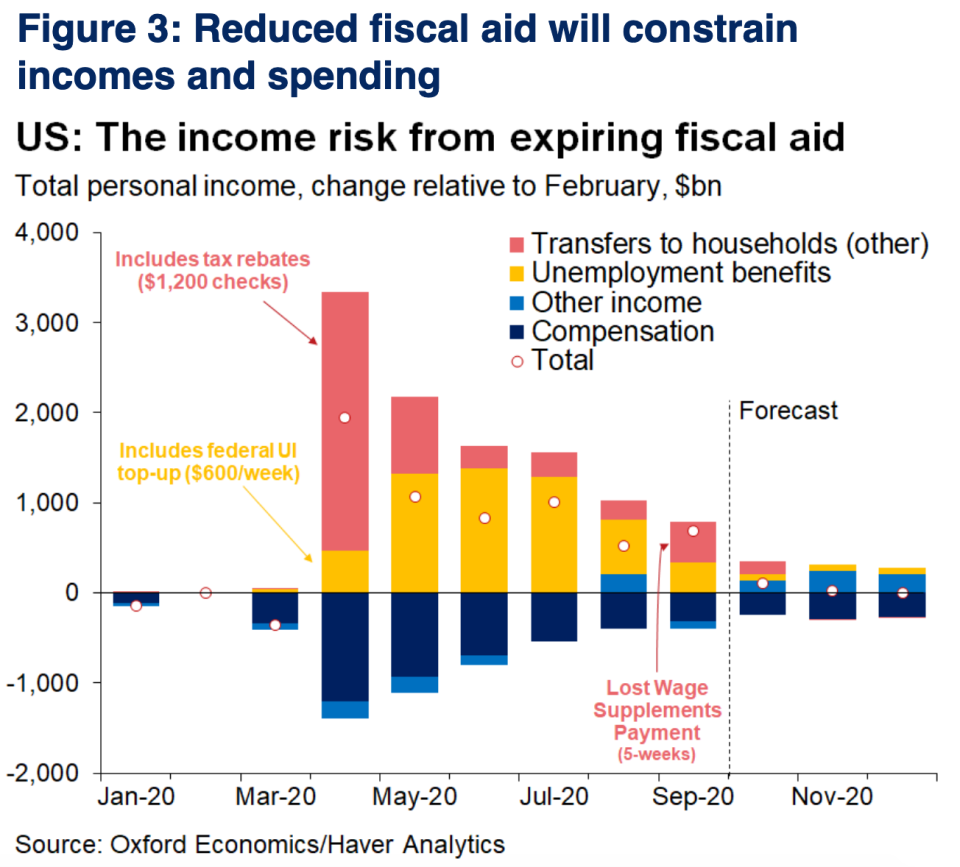Why vaccine developments argue for more fiscal stimulus: Morning Brief
Thursday, November 19, 2020
Get the Morning Brief sent directly to your inbox every Monday to Friday by 6:30 a.m. ET. Subscribe
Supporting the economy for a few months is easier than doing so indefinitely.
The positive news on COVID-19 vaccine developments continued on Wednesday.
Before the market open, Pfizer (PFE) and its German partner BioNTech (BNTX) announced that final results for their Phase 3 trial show the vaccine to be 95% effective.
This comes just two days after Moderna (MRNA) announced its COVID vaccine candidate was 94.5% effective and a little over a week after Pfizer’s preliminary results showed 90% efficacy in preventing infection. Pfizer is now set to apply for emergency use authorization for its vaccine from the FDA within days.
In an interview on CNBC on Wednesday, former FDA commissioner Scott Gottlieb said you can “effectively end” the pandemic with wide distribution of a vaccine with this level of efficacy. And with these developments, an end to the most acute phase of the pandemic is starting to come into focus.
But having line of sight on an eventual end to the present health emergency does not change the fact that the situation on the ground in the U.S. continues to deteriorate.
COVID hospitalizations are at a record. Deaths are on the rise. And the positive rate for COVID tests nationwide is now the highest it has been since May.
And vaccine developments offering a view on when or how this pandemic might end should heighten calls for more fiscal stimulus, not leave policymakers thinking that efforts to date have been and will remain adequate. As of now, any talks related to additional fiscal support appear to have stalled.
All while the surge in cases is starting to strain the economy.
“The resulting rise in virus fear and renewed social distancing measures are constraining sentiment and weighing on mobility and spending,” said Gregory Daco, chief U.S. economist at Oxford Economics.
“Household income is gradually falling back toward its pre-COVID level as fiscal aid no longer offsets the 10 million jobs shortfall relative to February and capped wages. In this environment, the recovery’s fragilities are becoming apparent.”
The following chart from Daco shows how the boost to incomes from various fiscal aid packages is set to run off in the months ahead absent fresh stimulus. Leaving U.S. households to face the cold weather, a surge in the virus, and an uncertain labor market without any of the support that helped consumers thrive through the spring and summer of 2020.

And so unlike March and April when there was no real sense of what would happen next medically, economically, and societally, the vaccine progress we’ve seen answers a lot of outstanding unknowns.
Distribution challenges and widespread acceptance from the public that the vaccine is safe to take are hurdles that we are yet to overcome.
But the pandemic is no longer an indefinite event.
There is reason to believe that in two or three quarters life in the U.S. will look fairly normal, that the virus will be well-contained, and that tens of millions of people will be inoculated.
Supporting the economy now to keep struggling businesses open and keep struggling households afloat is about getting us to these dates with an economy that remains resilient, not one wearing the scars of a recovery cut short by premature fiscal austerity.
By Myles Udland, reporter and anchor for Yahoo Finance Live. Follow him at @MylesUdland
What to watch today
Economy
8:30 a.m. ET: Initial jobless claims, week ended November 14 (700,000 expected, 709,000 during prior week)
8:30 a.m. ET: Continuing claims, week ended November 7 (6.4 million expected, 6.786 million during prior week)
8:30 a.m. ET: Philadelphia Fed Business Outlook index, November (23 expected, 32.3 in October)
10 a.m. ET: Leading Index, October (0.7% expected, 0.7% in September)
10 a.m. ET: Existing home sales, October (6.44 million expected, 6.54 million in September)
10 a.m. ET: Kansas City Federal Reserve Manufacturing Activity Index, November (10.5 expected, 13 in October)
Earnings
Pre-market
6:45 a.m. ET: BJ’s Wholesale Club (BJ) is expected to report adjusted earnings of 65 cents per share on revenue of $3.68 billion
6:55 a.m. ET: Macy’s (M) is expected to report adjusted earnings of 79 cents per share on revenue of $3.86 billion
Post-market
4 p.m. ET: Intuit (INTU) is expected to report adjusted earnings of 39 cents per share on revenue of $1.21 billion
4 p.m. ET: Ross Stores (ROST) is expected to report adjusted earnings of 61 cents per share on revenue of $3.43 billion
Top News
AstraZeneca/Oxford vaccine shows 'strong immune response' in all ages [Yahoo Finance UK]
European markets open weaker as COVID-19 cases and fatalities keep rising [Yahoo Finance UK]
Pound dips as European leaders 'demand EU ramps up no-deal Brexit plans' [Yahoo FInance UK]
Nvidia forecasts fourth-quarter revenue above expectations [Reuters]
YAHOO FINANCE HIGHLIGHTS
U.S. states are bleeding cash as pandemic drags on with no stimulus in sight
Larry Summers' tax advice for Biden: Collect on the $7 trillion owed by 'the richest taxpayers'
Richmond Fed's Barkin: Positive COVID-19 vaccine developments a 'light at the end of the tunnel'
—
Follow Yahoo Finance on Twitter, Facebook, Instagram, Flipboard, SmartNews, LinkedIn, YouTube, and reddit.
Find live stock market quotes and the latest business and finance news
For tutorials and information on investing and trading stocks, check out Cashay
